Topics
Category
Era
Rochester State Hospital
Rochester State Hospital opened on January 1, 1879, as Minnesota’s second hospital for the insane. It served as part of Minnesota’s state hospital system until 1982, when changing trends in treatment for the mentally ill and lack of funding led to its closure.
Rochester State Hospital began as the Minnesota Inebriate Asylum. In 1873, the state legislature passed a law that imposed a ten-dollar annual tax on liquor dealers to fund the building of an asylum for sufferers of alcoholism, then commonly called inebriates. The state purchased 160 acres of land in Rochester in 1876, and construction of the asylum began in 1877.
Liquor dealers strongly opposed the tax and successfully lobbied against it, arguing that there was a more urgent need for another hospital for the insane. In 1878, the legislature repealed the tax and abolished the inebriate asylum. In its place, they established the second Minnesota Hospital for the Insane to ease overcrowding at St. Peter, then the state’s only institution for the mentally ill. A portion of the new hospital was dedicated to treating chronic inebriates.
The hospital opened on January 1, 1879, with one hundred male patients transferred from St. Peter. It was built according to the Kirkbride plan, a design created by Dr. Thomas Kirkbride that set aside open stretches of land for farming, exercise, and occupational therapy. The original structure featured a central administration building with wings for patient wards stretching out behind it on either side. The first building was completed in 1880 but was expanded throughout the 1880s. In 1893, the institution changed its name to the Rochester State Hospital.
Treatment of mental illness at the hospital before the 1920s mainly involved keeping patients occupied with work and recreation, and restraining violent patients. Many patients worked on the hospital’s five-hundred-acre farm. Though physical punishment was not prescribed as a treatment, the hospital came under scrutiny in 1889 when patient Taylor Combs died at the hands of two attendants. Following this scandal, Dr. A. F. Kilbourne replaced the hospital’s first superintendent, Dr. J. E. Bowers.
Kilbourne, who served at Rochester until his death in 1935, was a firm believer in therapeutic occupation and amusement for patients as the most valuable forms of treatment. He tried to improve Rochester’s program so that it offered patients more light exposure and more interesting work. After his takeover in 1889, the hospital developed one of the first nurses’ training programs in the country. The first class graduated in 1892.
Treatment methods evolved throughout the hospital’s history. In the late 1940s, insulin and electroshock treatments were common. In the 1950s, lobotomies were used on some patients, and drug use became more extensive. The hospital’s campus continued to change as well. After World War II, there was an influx of geriatric patients. With the old Kirkbride building unable to accommodate them, a major construction program began in 1948. By 1964, newer buildings served most of the patients and the Kirkbride structures were torn down. In 1965, the City of Rochester purchased 212 acres of the hospital’s farm land and turned it into Quarry Hill Park.
By the 1960s, the hospital was known for its surgical unit. It served as a center for many other state institutions, and by 1971 was the only remaining surgical unit in the state hospital system. In the same year, it became the surgical center for the Department of Public Welfare.
In the late 1970s, as the economy declined, the treatment of mental illness moved from state institutions to community-based facilities. In 1981, the Minnesota Legislature ordered Rochester to close as a cost-saving measure, triggering a state-wide controversy. Hospital staff and community members expressed concern that the closure would traumatize patients and damage the local economy. Unlike other state hospitals, which received patients through court orders, Rochester admitted a majority of its patients voluntarily. Patient advocates feared that closing the hospital would hurt those who sought help willingly. Despite these objections, the hospital closed in June 1982.
The Federal Medical Center, a prison for inmates with medical problems, was built on the hospital’s grounds in 1984. The prison used some of the detached hospital buildings but demolished others to allow for new construction.
Bibliography
Editor’s note: This article has been repurposed from an overview of Rochester State Hospital’s administrative history written by State Archives staff.
“Closing of RSH Creating Problems for Community.” Rochester Post Bulletin, January 1, 1982.
Hansel, Jeff. “Was Closing the Rochester State Hospital a Good Idea?” Rochester Post Bulletin, March 22, 2013.
Originally found at: http://www.postbulletin.com/news/local/was-closing-the-rochester-state-hospital-a-good-idea/article_81bc7b63-7ed6-5863-9900-73648d8a909f.html
McCracken, Ken. “ABC Workers Worried by Closing of State Hospital.” Rochester Post Bulletin, December 31.
——— . “Minnesota’s State Hospitals Said In Danger Of Taking Step Into Past.” Rochester Post Bulletin, December 31, 1981.
——— . “RHS Patient Load May Cause Anxious Time at St. Peter.” Rochester Post Bulletin, December 31, 1981.
——— . “Rochester State Hospital’s Closing Running on Schedule.” Rochester Post Bulletin, December 31, 1981.
"New Methods of Treating Insane at Rochester." St. Paul Globe, February 23, 1902.
Medical Director Subject Files, 1967–1982
Rochester State Hospital
State Archives Collection, Minnesota Historical Society, St. Paul
http://www2.mnhs.org/library/findaids/gr00064.xml
Description: Reports, correspondence, memos, circulars, newsletters, and miscellaneous materials of medical director Francis A. Tyce and assistant medical director Glen M. Duncan.
Minnesota State Planning Agency. “Minnesota’s State Hospitals.” January 31, 1985.
http://mn.gov/mnddc/learning/document/GT033.PDF
Minnesota Department of Public Welfare. “The Future of Minnesota’s State Hospital System.” November 1982.
http://mn.gov/mnddc/past/pdf/80s/82/82-mn-dpw-mn-hosp-future1.pdf
——— . Minnesota's Mental Health Program in Perspective: A Comprehensive Summary. 1965.
http://mn.gov/mnddc/past/pdf/60s/65/65-DPW-MHP.pdf
Kilbourne, Arthur. "Minnesota in the Development of the Care of the Insane." American Journal of Psychiatry 84 (1929): 1077–1083.
Murphy, Patricia. The Public Buildings of the State of Minnesota: An Architectural Heritage. St. Paul: Minnesota Historical Society, 1986.
Rochester State Hospital: 1879–1951, Rochester, Minnesota. [MN]: N.p., 1951.
Related Resources
Primary
Andrist, Steve. “State Hospital Closing May Not Be All Bad For Patients.” Rochester Post Bulletin, December 31, 1981.
"Killed by Attendants." Rochester Post, June 7, 1889.
"Report of the Grand Jury." Rochester Post, June 21, 1889.
Patient Records, Miscellaneous, 1879–1980s
Rochester State Hospital
State Archives Collection, Minnesota Historical Society, St. Paul
http://www2.mnhs.org/library/findaids/gr00669.xml
Description: Miscellaneous records containing information on individual patients.
Patient Registers and Indexes, 1879-1965
Rochester State Hospital
State Archives Collection, Minnesota Historical Society, St. Paul
http://www2.mnhs.org/library/findaids/gr00099.xml
Description: The indexes list surname, case file number, and admission and discharge dates. The registers list all patients admitted to the hospital and record case number, name, county, admission date, age, civil condition, occupation, education, religion, habits, nativity, nativity of parents, diagnosis, suicidal or homicidal, number of attack, number of admission, age at first attack, duration of insanity, time in hospital, date discharged, result, and observations.
Reising, Jerry. “State Hospital Closing Was Partisan.” Rochester Post Bulletin, May 31, 2006.
Surgical Department Miscellaneous Records, 1960–1981
Rochester State Hospital
State Archives Collection, Minnesota Historical Society, St. Paul
http://www2.mnhs.org/library/findaids/gr00816.xml
Description: Includes policy and program manuals, minutes of various committee meetings, complimentary letters, treatment registers, and other materials relating to the surgery department and operating room.
Secondary
Alternatives to Economic Dislocation: A Feasibility Study. [MN: The Working Group], 1985.
Amdur, M.K. “A Psychiatric Bulletin in Minnesota of Half a Century Ago: A Chapter of Psychiatric Journalistics.” Minnesota Medicine 25, no. 9 (September 1942): 732–735.
Kirkbride, Thomas. On the Construction, Organization and General Arrangements of Hospitals for the Insane. Philadelphia: J.B. Lippincott, 1854.
Web
Forgotten Minnesota. Architecture of the State—The Rochester State Hospital.
http://forgottenminnesota.com/2014/08/architecture-of-the-state-the-rochester-state-hospital/
Minnesota Historical Society, Placeography. Rochester State Hospital.
http://www.placeography.org/index.php/Rochester_State_Hospital,_2110_East_Center_Street,_Rochester,_Minnesota
The Quarry Hill Nature Center. History.
http://www.qhnc.org/history.html
Related Images

Women reading in library, Rochester State Hospital
Holding Location
Articles
More Information
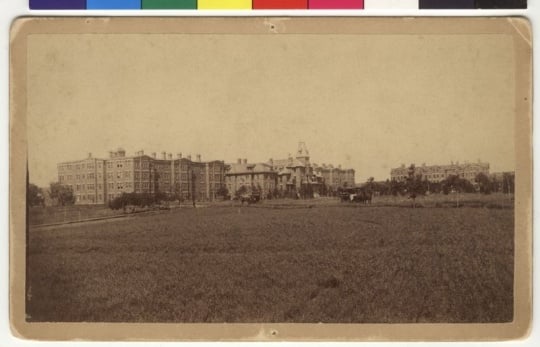
Rochester State Hospital
Public domain
Holding Location
More Information
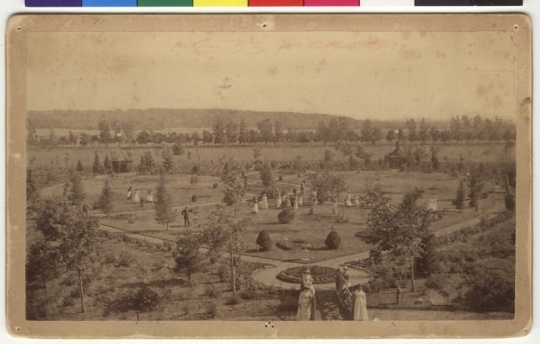
Rochester State Hospital grounds
Public domain
Holding Location
Articles
More Information
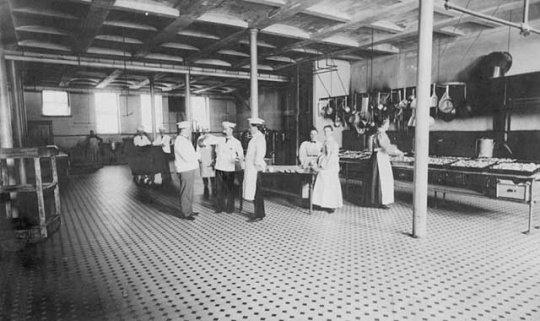
Kitchen, Rochester State Hospital
Public domain
Holding Location
Articles
More Information
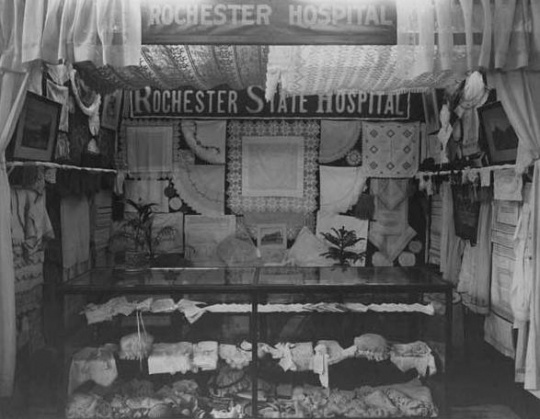
Rochester State Hospital exhibit at the State Fair
Public domain
Holding Location
Articles
More Information
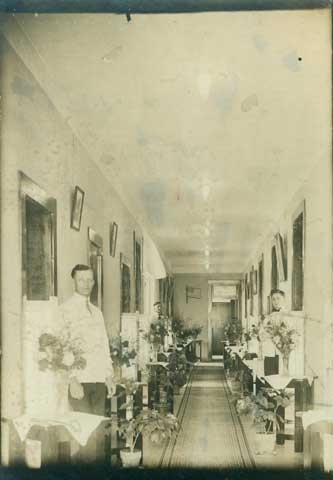
Interior, Rochester State Hospital
Public domain
Holding Location
Articles
More Information
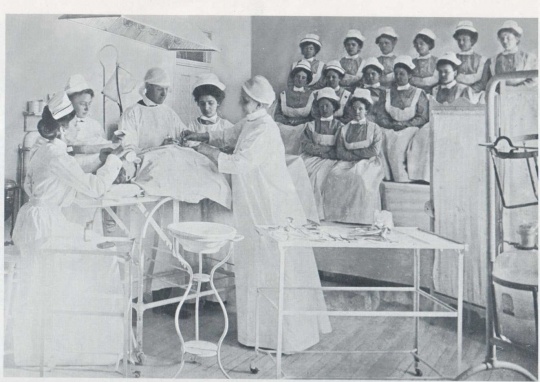
Laura Linton at Rochester State Hospital
Public domain
Holding Location

Personnel, Rochester State Hospital
Holding Location
Articles
More Information
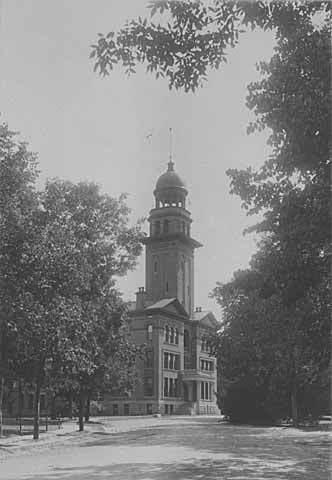
Administration Building of the Rochester State Hospital
Holding Location
Articles
More Information
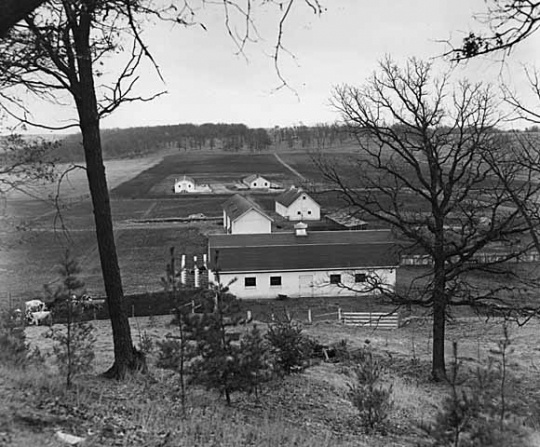
Farm buildings, Rochester State Hospital
Holding Location
Articles
More Information
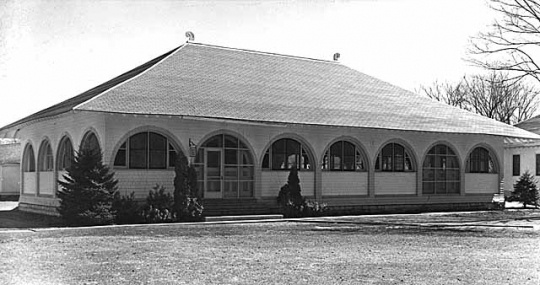
Occupational therapy cottage, Rochester State Hospital
Holding Location
Articles
More Information

Library, Rochester State Hospital
Holding Location
Articles
More Information
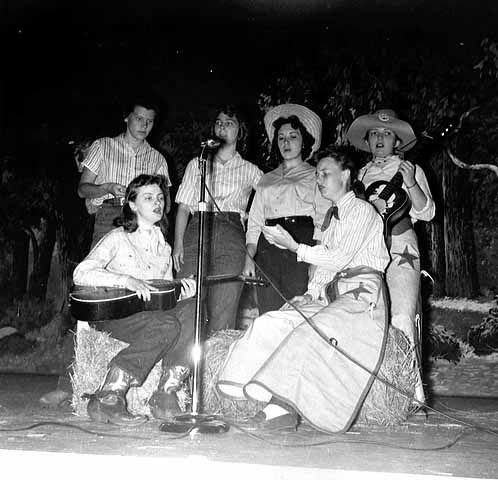
Student nurses putting on a musical program for patients at Rochester State Hospital
Holding Location
Articles
More Information
Related Articles
Turning Point
In 1878, the Minnesota State Legislature repeals the annual tax on liquor dealers meant to fund an Inebriate Asylum and establishes in its place the Second Minnesota Hospital for the Insane (later renamed Rochester State Hospital).
Chronology
1873
1877
1878
1879
1880
1889
1892
1893
1948
1964
1965
1971
1981
1982
1984
Bibliography
Editor’s note: This article has been repurposed from an overview of Rochester State Hospital’s administrative history written by State Archives staff.
“Closing of RSH Creating Problems for Community.” Rochester Post Bulletin, January 1, 1982.
Hansel, Jeff. “Was Closing the Rochester State Hospital a Good Idea?” Rochester Post Bulletin, March 22, 2013.
Originally found at: http://www.postbulletin.com/news/local/was-closing-the-rochester-state-hospital-a-good-idea/article_81bc7b63-7ed6-5863-9900-73648d8a909f.html
McCracken, Ken. “ABC Workers Worried by Closing of State Hospital.” Rochester Post Bulletin, December 31.
——— . “Minnesota’s State Hospitals Said In Danger Of Taking Step Into Past.” Rochester Post Bulletin, December 31, 1981.
——— . “RHS Patient Load May Cause Anxious Time at St. Peter.” Rochester Post Bulletin, December 31, 1981.
——— . “Rochester State Hospital’s Closing Running on Schedule.” Rochester Post Bulletin, December 31, 1981.
"New Methods of Treating Insane at Rochester." St. Paul Globe, February 23, 1902.
Medical Director Subject Files, 1967–1982
Rochester State Hospital
State Archives Collection, Minnesota Historical Society, St. Paul
http://www2.mnhs.org/library/findaids/gr00064.xml
Description: Reports, correspondence, memos, circulars, newsletters, and miscellaneous materials of medical director Francis A. Tyce and assistant medical director Glen M. Duncan.
Minnesota State Planning Agency. “Minnesota’s State Hospitals.” January 31, 1985.
http://mn.gov/mnddc/learning/document/GT033.PDF
Minnesota Department of Public Welfare. “The Future of Minnesota’s State Hospital System.” November 1982.
http://mn.gov/mnddc/past/pdf/80s/82/82-mn-dpw-mn-hosp-future1.pdf
——— . Minnesota's Mental Health Program in Perspective: A Comprehensive Summary. 1965.
http://mn.gov/mnddc/past/pdf/60s/65/65-DPW-MHP.pdf
Kilbourne, Arthur. "Minnesota in the Development of the Care of the Insane." American Journal of Psychiatry 84 (1929): 1077–1083.
Murphy, Patricia. The Public Buildings of the State of Minnesota: An Architectural Heritage. St. Paul: Minnesota Historical Society, 1986.
Rochester State Hospital: 1879–1951, Rochester, Minnesota. [MN]: N.p., 1951.
Related Resources
Primary
Andrist, Steve. “State Hospital Closing May Not Be All Bad For Patients.” Rochester Post Bulletin, December 31, 1981.
"Killed by Attendants." Rochester Post, June 7, 1889.
"Report of the Grand Jury." Rochester Post, June 21, 1889.
Patient Records, Miscellaneous, 1879–1980s
Rochester State Hospital
State Archives Collection, Minnesota Historical Society, St. Paul
http://www2.mnhs.org/library/findaids/gr00669.xml
Description: Miscellaneous records containing information on individual patients.
Patient Registers and Indexes, 1879-1965
Rochester State Hospital
State Archives Collection, Minnesota Historical Society, St. Paul
http://www2.mnhs.org/library/findaids/gr00099.xml
Description: The indexes list surname, case file number, and admission and discharge dates. The registers list all patients admitted to the hospital and record case number, name, county, admission date, age, civil condition, occupation, education, religion, habits, nativity, nativity of parents, diagnosis, suicidal or homicidal, number of attack, number of admission, age at first attack, duration of insanity, time in hospital, date discharged, result, and observations.
Reising, Jerry. “State Hospital Closing Was Partisan.” Rochester Post Bulletin, May 31, 2006.
Surgical Department Miscellaneous Records, 1960–1981
Rochester State Hospital
State Archives Collection, Minnesota Historical Society, St. Paul
http://www2.mnhs.org/library/findaids/gr00816.xml
Description: Includes policy and program manuals, minutes of various committee meetings, complimentary letters, treatment registers, and other materials relating to the surgery department and operating room.
Secondary
Alternatives to Economic Dislocation: A Feasibility Study. [MN: The Working Group], 1985.
Amdur, M.K. “A Psychiatric Bulletin in Minnesota of Half a Century Ago: A Chapter of Psychiatric Journalistics.” Minnesota Medicine 25, no. 9 (September 1942): 732–735.
Kirkbride, Thomas. On the Construction, Organization and General Arrangements of Hospitals for the Insane. Philadelphia: J.B. Lippincott, 1854.
Web
Forgotten Minnesota. Architecture of the State—The Rochester State Hospital.
http://forgottenminnesota.com/2014/08/architecture-of-the-state-the-rochester-state-hospital/
Minnesota Historical Society, Placeography. Rochester State Hospital.
http://www.placeography.org/index.php/Rochester_State_Hospital,_2110_East_Center_Street,_Rochester,_Minnesota
The Quarry Hill Nature Center. History.
http://www.qhnc.org/history.html














